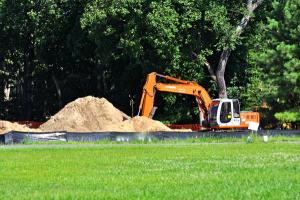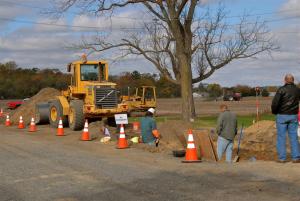Bones discovered at Hawkseye construction site
Workers at a construction site in the Hawkseye development near Lewes uncovered what appeared to be three sets of human remains Aug. 13. As of press time, it has yet to be determined how long the bones have been buried or their origin.
Work has stopped at the site until archeologists complete an investigation. Under the Unmarked Human Remains Law, the bones must be protected from further damage.
Clifford Diver Jr., principal of property owner LBV Partners, was out of town when the bones were found. He said the medical examiner called to the scene found the remains were not from recent times.
In addition, officials determined that the site was not a crime scene based on factors such as location and depth of the burial, said Kimberly Chandler, director of community relations for the Delaware Department of Safety and Homeland Security.
She said representatives from Delaware State Police, Delaware Division of Forensic Science and Delaware Division of Historical and Cultural Affairs responded to the scene after the discovery by workers digging at the site.
State protocol requires that an archeologist be called to the scene to further examine the site and the remains to try to ascertain their origin. Two state archeologists and an independent archeologist have worked at the site.
Investigation is underway
Independent archeologist Edward Otter is working with the Division of Historic and Cultural Affairs/Historic Preservation Office to help identify the cultural affiliation of the remains, how many graves are present at the site and what steps to take to deal with the remains once the investigation is concluded.
“This involves discussions with the landowner, possibly attorneys and the Historic Preservation Office to determine how to move forward,” Otter said.
Otter said the investigation is in the preliminary stages. “It's too early for details; we are doing what is legally required,” he said.
While division protocol requires that an approximate time period of remains be determined within 24 hours, Deputy State Historical Preservation Officer Gwen Davis said they have not yet gathered enough information.
“Some cases are very clear, but this case is not,” she said. “We are meeting with the property owner and his archeologist later this week.”
Davis said it's not unusual for property owners or developers to hire independent archeologists when remains are uncovered. “They work in consultation with this office,” she said. In this case, she said, it's helpful because Otter responded quickly.
Otter said when determining cultural origin, archeologists look at several indicators, including how remains are buried, if coffins are used, if arrowheads are present and the time period of any artifacts found in or near a grave. The results of the investigation will determine how to move forward, he said.
If the remains are determined to be from a historical period cemetery or burial, the division advertises for next-of-kin based on the date of the burials and the ownership of the property, according to division regulations.
But, if the remains are Native American, a committee defined by law convenes to develop a treatment and disposition plan.
Ultimately, the division will write a plan for the treatment and disposition of the remains in consultation with next-of-kin – if they come forward – or the Native American committee, landowner, developer or other representative.
The grave or graves could be removed and interred at another location. Based on division protocol, the preferred option for reburial is to return remains to the original location. If that is not possible, remains can be re-interred in a cemetery. Next-of-kin also have the option of claiming their relatives and paying for re-interment in a cemetery and plot of their choice.
Otter: Surprised more remains not found
Otter said it's rare that human remains are found in the area. “But I'm surprised it doesn't happen more often, especially in the Lewes area,” he said. “We know there are Indian burial sites all along Canary Creek and Love Creek and family cemeteries all over the place.”
Otter was involved in another case involving about 60 remains found in Oak Orchard during excavation work on a Sussex County sewer project. Those remains were determined to be from the Colonial era, and some bones were sent to the Smithsonian Institution for analysis and research.
He said if the remains are from that time period, they could also be studied by the Smithsonian. However, he said, if the remains are determined to be Native American, it's doubtful further analysis will take place. Traditionally, he said, Native Americans do not want remains disturbed.
Diver said officials are worried that people will want to try to find bones at the site. He warned that it is a crime for anyone to disturb the site or remove material. Displaying photos showing family remains is a crime, he said. No trespassing signs have been posted, he said.
Diver asks that the public show respect for the people whose remains were uncovered and refrain from approaching the site.


























































